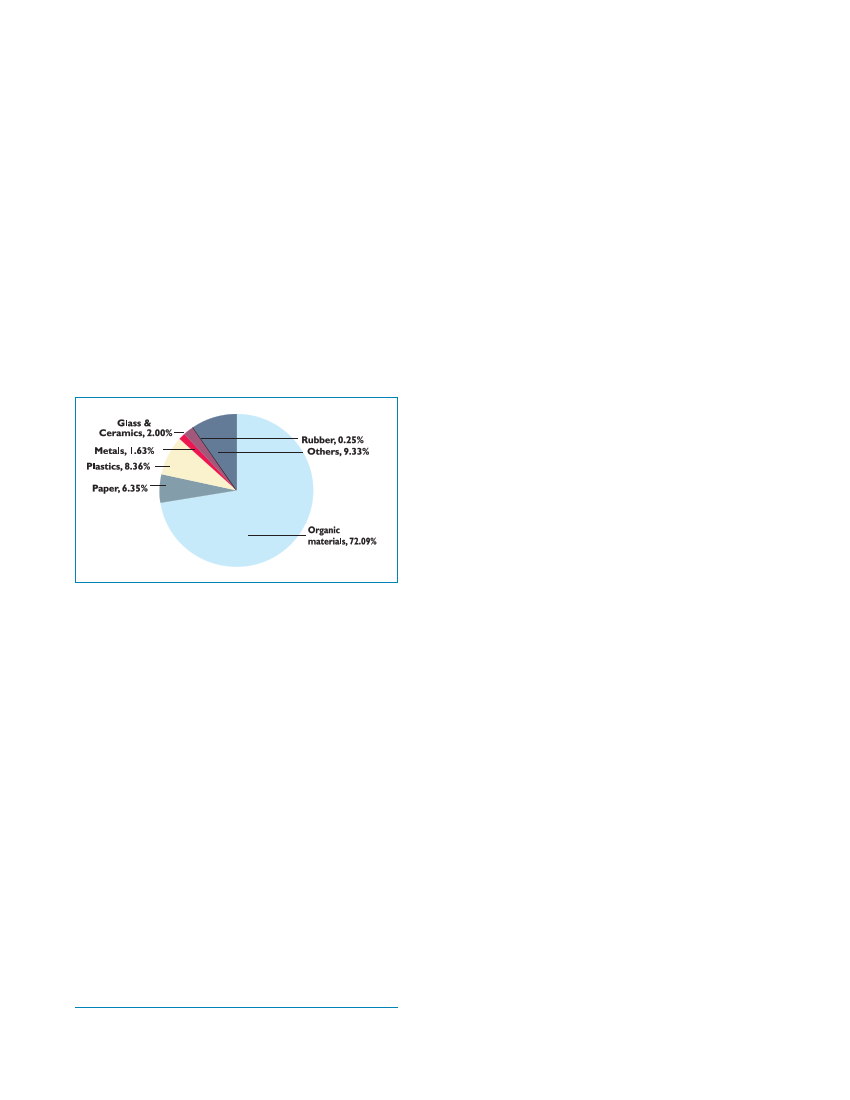
BEST PRACTICES ON SOLID WASTE MANAGEMENT OF NEPALESE CITIES
strike33 in 2006, when local residents refrained from
dumping waste in public places (WEPCO, 2008 data).
Waste generation and composition
According to the data provided by WEPCO and a field
survey conducted in June 2008, the average HH waste
generation rate in ward no. 1 of Lalitpur is 0.35kg/
capita/day, which is more than the national average of
0.25kg/capita/day and less than Kathmandu
metropolitan city, which is 0.39kg/capita/day
(SWMRMC, 2008 data).
Chart 10: Composition of solid waste at source
(WEPCO data, 2008)
Transport and final disposal
There are four handcarts that can each carry 50 kg, ten
rickshaws each able to transport 300 to 500 kg and two
environmentally friendly, battery-powered vehicles of 1 ton
capacity for solid waste collection and transport (WEPCO,
2008 data). WEPCO deposits its 3 tons of waste each day in
a 2-ton container provided by LSMC or dumps it at the
Bagmati riverside dumping site (WEPCO, 2008 data).
Organizational and
financial aspects
According to information provided by WEPCO, it has 35
full time staff (WEPCO, 2008 data). The income of this
organisation is derived from waste collection charges
and the sale of compost, paper for recycling, and recycled
products. In the fiscal year 2007, the income earned from
solid waste recycling and reuse was about NRs.1 million
(WEPCO, 2007 data). The waste collection charges per
month are NRs.30-100 from HHs and NRs.50-100 from
shops (WEPCO, 2007 data). Expenditures are about the
same as the total income, suggesting that the WEPCO
model is financially sustainable.
Waste collection and handling
Daily collection from HHs is provided for 1200 HHs of
ward no.1 and for some parts of wards no. 10 & 20
(approximately 400 HHs). Ten rickshaws, each with a
capacity to carry 300 - 500 kg, are used for waste
collection and later dump it at the transfer point
designated by LSMC. During the field visit it was learned
that door-to-door waste collection is considered to be a
WEPCO pilot programme. There is a paper recycling
plant and a composting plant with monthly production
capacity of two tons of compost.
In order to ensure effective waste collection, WEPCO
distributed red and green bins – big enough for 10kg –
to every HH in the project area for paper and plastic
collection. The “Give plastic and take compost”
campaign is also a popular WEPCO programme that
aims to generate awareness of organic and inorganic
solid waste reduction and segregation.
Major problems and issues
Despite its effective system of door-to-door waste
collection, WEPCO needs additional finance to extend the
coverage. WEPCO suffers from a shortage of staff, vehicles
and other resources. Additional obstacles are caused by
the poor institutional set-up of government organisations
and the lack of legislation to encourage NGOs.
Nevertheless, WEPCO has definitely achieved its goal
regarding effective waste collection and waste reduction.
It was honoured by the award of the UNEP Global 500
Environmental Award in 2003, a Ministry of Population
award in1996 and the WWF Nepal Programme Abraham
Conservation Award in 2003.
Plans and developments
WEPCO plans to expand training in resource
management to all the wards in five municipalities of
Kathmandu valley area.
33 A nationwide strike against autocratic rule lasted for 19 days in 2006
46